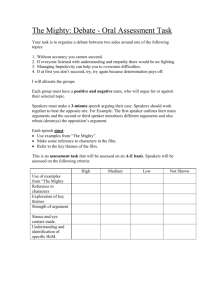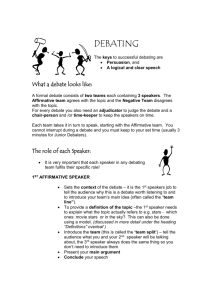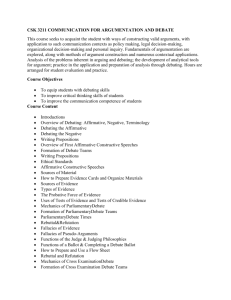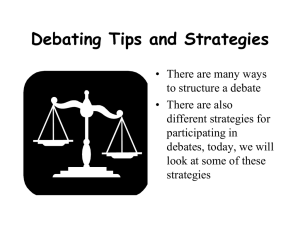Debating: A Brief Introduction for Beginners
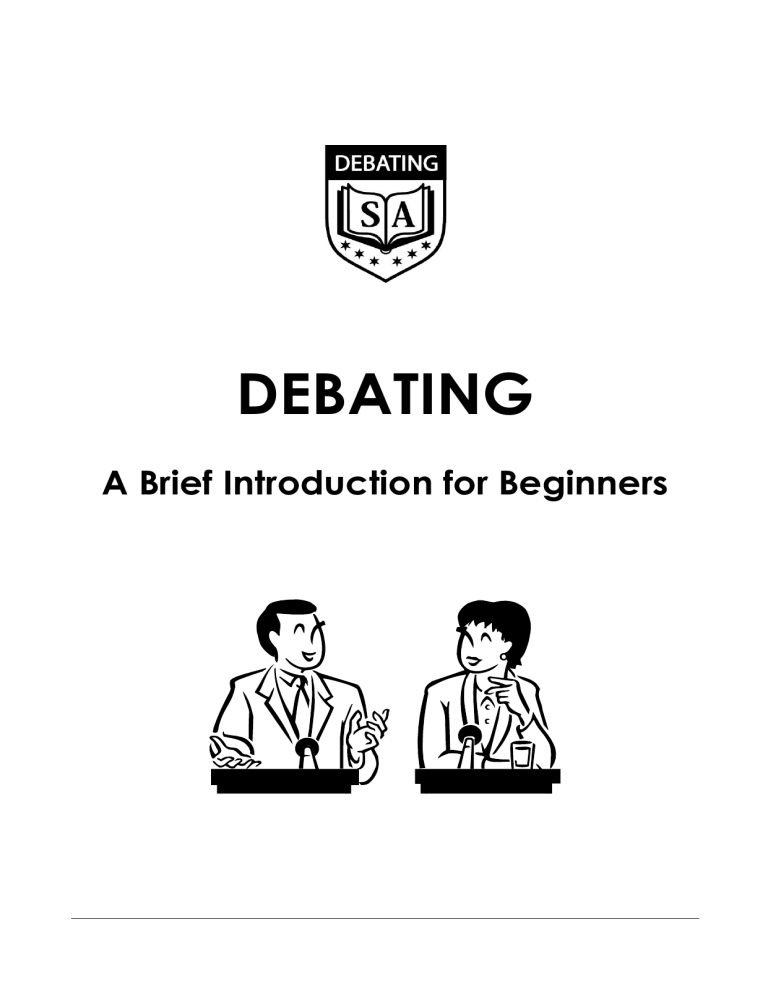
DEBATING
A Brief Introduction for Beginners
WHAT IS DEBATING?
We live in a world where we communicate with others all the time. Debating is a more formal way of communicating. It builds confidence and self esteem in people.
If we can speak publicly and convey our ideas and thoughts coherently and passionately, we have a valuable tool that can aid us in our public, private and future lives.
Rules
A debate has two teams: an Affirmative and a Negative. Each side consists of three speakers. The First Affirmative speaker begins the debate, and is then followed by the First Negative speaker. This pattern is maintained for the second and third speakers of each team. Each speaker speaks for a set time, with a warning bell, to give them a little time to sum up and finish, then a final bell.
Each speaker has certain ‘duties’ to attend to as they speak (see ‘Duties of
Speakers’).
All debaters must begin with “Madam/Mr Chairman, Ladies and Gentlemen”.
A debater may have an interesting opening which s/he may use just before
“Madam Chairman etc…” which is fine.
Speakers don’t have to say “thank you” when they finish, but may if they wish.
Room Layout
A debate is set up as shown in the diagram below.
© 2008 Debating SA Incorporated. All rights reserved. Page 1 of 11
DEBATING CONTENT
Each speaker is awarded a score out of 100 which is divided as follows:-
Argument 50
Presentation 30
Structure 20
Argument is the argument, evidence and proof of the team’s case and its disproof of the other side’s case. It also includes the definition and interpretation of the topic.
Presentation is how the speaker presents his/her arguments physically. It's a speaker's style, and includes things like eye contact, gestures, stance, deportment and voice.
Structure is the individual form (i.e. structure) of a speaker’s speech and how that speech links into speeches of the rest of that speaker’s team.
Definition and Interpretation
The definition of the topic consists in the first instance of defining individual or key words of the topic. The interpretation is the establishment or explanation of the meaning or significance of the topic as a whole.
The definition and interpretation of the topic should be outlined by the First
Affirmative speaker. The Negative team must either agree or disagree with the
Affirmative team’s definition and interpretation.
How to define the topic:
1.
Select the key words from the topic and look up their meanings in a range of dictionaries, choosing the most appropriate definition for each word.
2.
Interpret the topic.
3.
Formulate a sentence which explains the topic using the dictionary definitions
(in the case of a literal interpretation), or the context of the topic (in the case of a figurative interpretation).
© 2008 Debating SA Incorporated. All rights reserved. Page 2 of 11
Topic Interpretation
Occasionally, the two teams may have a different interpretation of the topic. No one side has a right to the definition, and as long as a side can support its interpretation and attack the opposition's interpretation and argument with rebuttal of the form “even if we agreed to the topic which we don't, the opposition arguments are wrong because…” the team’s interpretation and rebuttal is valid.
The exception to this is where a team has ‘defined’ a topic in such a way as to render it senseless as in the case of sayings. For instance, “A chip off the old block” when interpreted as individual words from a dictionary does not maintain the integrity of the meaning. A much better interpretation would be to explain the meaning of the phase in its entire context.
A team which adopts a quirky interpretation often has a hard time finding evidence to support its case. However, there are occasions when both teams have a viable and valid interpretation of the topic and good arguments for each case.
In such a case the debate will be awarded based on whose interpretation and argument was most convincing.
If one side has a reasonable interpretation but poor arguments to support its case, low marks in the Argument section would reflect that.
© 2008 Debating SA Incorporated. All rights reserved. Page 3 of 11
PREPARING YOUR ARGUMENTS
As a debater, it’s important that you make points that are clear, relevant and easy to understand. The use of a verbal illustration or an analogy may help you to clarify complicated terms.
However, you should remember that examples are not proof of a point.
An effective way of constructing your argument is to arrange it with the least important point first to most important point last. People generally remember what has been said last.
In presenting and developing your argument remember to explain what you mean to prove, what the scope and implication will be, and why it is true with facts and evidence (not just assertions) to support your case.
Planning
There are a number of things that you can do in preparation for a debate. Below are some suggestions.
Keep up with newspapers, magazines and books
Record material, ideas and keep notes
Observe and assess other speakers, including public figures
Evaluate your material
Talk to other people, ask their opinions
Open a file and keep articles, quotes or humorous cartoons.
Learn to express your thoughts in a more word enriched way
– develop word pictures. Use a dictionary or thesaurus to improve your vocabulary.
Your Argument
You will feel a lot happier approaching a debate if your preparation has been thorough. Explore your topic, discuss it with friends, look through books etc. to help support your argument. If you believe in what you are saying you will convince your audience as well. Have the strength of your convictions (sometimes after research we can truly see both sides of the coin!).
© 2008 Debating SA Incorporated. All rights reserved. Page 4 of 11
Notes
Keep notes short and succinct on small cards, but in big writing. Number each card so that if they fall you can sort them easily. Notes are a little reminder of what you want to say. You rule them, not they you.
Timing
Before your debate, you need to run through roughly what you are to say so that you can be confident of your timing.
If your speech is too short, expand on some of your material, give examples, or analogies.
If your speech is too long, is some information irrelevant, is there too much padding?
What you say
Keep a dictionary or thesaurus handy to improve your vocabulary. You don’t have to be pretentious or use 26 syllable words, but an extended vocabulary makes what you say more interesting. Humour can go a long way in getting a message across. Keep a file of jokes and cartoons which may come in handy. Quotes of famous people also help to substantiate your point of view.
Two important things to remember:-
1.
Think of your opening – exactly what you are going to say – it has to grab everyone’s attention
2.
End on a positive note firmly expounding your view (possibly with a quote).
A strong opening and a strong finish will give you confidence.
© 2008 Debating SA Incorporated. All rights reserved. Page 5 of 11
PRESENTATION
Everyone has their own personality and style when it comes to debating. Some very convincing debaters have very subdued, but forceful styles
You don’t have to be outgoing, in fact, too dramatic is off-putting.
It’s helpful to keep the following in mind:-
1.
Develop eye contact with the audience
2.
Use your hands and body naturally to emphasise points
3.
Speak clearly
4.
Vary your voice pitch and modulation
5.
Don’t speak too quickly
Hints
1.
Don’t write your debate in full – make headings and notes on your cue cards.
2.
Number each card
3.
Avoid slang – use good conversational English.
4.
Open and close your speech with a device such as a joke, illustration, or quote.
How to speak
Speaking and talking are different things. When we talk we are often interrupted, but when we debate, we are able to speak uninterrupted.
This can be difficult. We may feel uncomfortable at being the centre of attention and so our anxiety becomes heightened. As a result, we may:-
1.
speak too quickly
2.
speak too softly
3.
have poor diction (too nervous, lockjaw sets in)
4.
monotonous
All of the above plus others can be overcome. Firstly, take pleasure in the fact that you now have a chance to air your views, uninterrupted for a few minutes. The audience is there because they want to hear what you have to say. Don’t disappoint them. Secondly, remember that you can discard the Negative inside messages and develop a balanced view about yourself and your self worth and self esteem.
© 2008 Debating SA Incorporated. All rights reserved. Page 6 of 11
Types of speakers
Those who speak from the mouth have given little thought or preparation to their work – they like the sound of their own voice.
Those who speak from the head have lots of facts and figures but are very boring and dry.
Those who speak from the heart are very emotional. Some of the great orators spoke from the heart.
What we need to do in debating is find a balance between the three. Which one are you? How do you need to balance your presentation?
Speaking
A number of things make up how we sound to other people when we speak. These are some of those elements that make up our speech:-
Tone
Volume
Rhythm and cadence
Pitch
Modulation
When debating you need to slightly exaggerate these, more so than if you were just speaking to a friend. Record your voice so that you can hear how it sounds and the adjustments you need to make.
Points to remember
Speak clearly and slowly, give time for your words to sink in, especially after a question. Pauses can be very effective.
Modulate your voice so that it has an up and down sound about it.
Feel confident about what you are saying and you’ll avoid ‘ums’, ‘errs’ and the like.
Use verbal emphasis, e.g. “No” can be said in a number of ways, loud or soft, to catch people’s attention.
© 2008 Debating SA Incorporated. All rights reserved. Page 7 of 11
Body language
How you stand and move your head, eyes and hands, will help to convey your message in a very powerful way. Stand tall, shoulders back. You’ll look and feel confident. When you pause, look at the audience. Maintain good eye contact by looking at individuals within the audience (this also gives you feedback – are they going to sleep? Do you need to speak with more emotion? They look puzzled. Are you speaking too quickly or softly?)
Large hand gestures are good. Think of yourself as larger than life. There may be some distance between yourself and the audience, small gestures may be lost.
Here are some things to avoid:-
1.
Shifting your weight from foot to foot repeatedly. It’s a nervous reaction which is then conveyed to the audience.
2.
Keep reading your notes. When your head is bowed it’s hard to hear, and you lose eye contact with the audience.
3.
Shuffling your notes. This may make you look nervous and is distracting.
4.
Personal Peccadilloes (e.g. twirling hair, pulling on ear). This is very
distracting.
© 2008 Debating SA Incorporated. All rights reserved. Page 8 of 11
STRUCTURE
Structure is comprised of the following two things:-
1. Individual speaker form
How the speech was constructed. Was it easy to follow? Was it in a logical sequence, and ordered? Did it follow an organised plan with a good introduction and conclusion?
2. Team plan
Did the speaker (as in the case of the First Affirmative and Negative) introduce the remaining speakers and what they were going to do? Did s/he refer to the team outline and plan, e.g. "as our first speaker said ..."
Points may be deducted if a speaker does not perform the tasks expected of him/her.
Debates are not three individual speeches.
Each team has a case, an outline and a theme.
All speakers need to link into their own speakers, and not contradict each other.
They must vigorously defend the case, and rebut (except the first Affirmative speaker) the other side.
© 2008 Debating SA Incorporated. All rights reserved. Page 9 of 11
DUTIES OF SPEAKERS - AFFIRMATIVE
1st Speaker
Introduction
Definition and interpretation
Introduction of speakers (also called Team Split)
Arguments, reasons and evidence
Summary of own case
Conclusion (also called Ending)
2nd Speaker
Introduction
Rebuttal
Summary of own first speaker (optional)
Arguments, reasons and evidence
Summary of team case
Conclusion (also called Ending)
3rd Speaker
Introduction
Rebuttal
Summary of team case
Conclusion (also called Ending)
© 2008 Debating SA Incorporated. All rights reserved. Page 10 of 11
DUTIES OF SPEAKERS - NEGATIVE
1st Speaker
Introduction
Definition: agree, amend, or reject definition of Affirmative. If reject then justify.
Rebuttal
Introduction of speakers (also called Team Split)
Arguments, reasons and evidence
Summary of own case
Conclusion (also called Ending)
2nd Speaker
Introduction
Rebuttal
Summary of own first speaker (optional)
Arguments, reasons and evidence
Summary of team case
Conclusion (also called Ending)
3rd Speaker
Introduction
Rebuttal
Summary of team case
Conclusion (also called Ending)
No new arguments except as specific rebuttal, not as new substantiation of own case.
© 2008 Debating SA Incorporated. All rights reserved. Page 11 of 11


